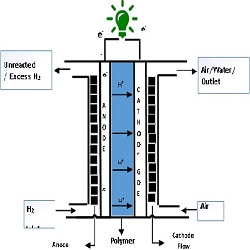
Arunkumar Jayakumar
Auckland University of Technology, New Zealand
Title: Measurement techniques and related challenges involved in the gas diffusion electrode characterization of PEM fuel cell stack
Biography
Biography: Arunkumar Jayakumar
Abstract
Proton Exchange Membrane (PEM) fuel cells are emerging as a commercially viable alternative for the production of clean and reliable energy. The Membrane Electrode Assembly (MEA) is the principal component of a PEM fuel cell. The operation of the fuel cell involves the hydrogen (fuel) being supplied to the anode and oxygen/air being fed to the cathode. At the anode region, the hydrogen is oxidized to protons and electrons the membrane allows protons to pass through it while the electrons are forced to travel through the external circuit. At the cathode, the oxidant is reduced and in this way, electricity is drawn from the cell. Figure 1 illustrates a single PEM cell, indicating various sub-components and the charge transfer. PEM fuel cell performance is meticulously correlated to the gas diffusion electrodes (GDE). GDE in a PEM fuel cell stack usually comprises of the catalyst layer and the gas diffusion layer and the present paper provides a comprehensive measurement issues pertaining to the characterization of GDE. The various GDE characterizations (in situ and ex situ) and the corresponding instrument involved in the present paper is listed as follows in the table 1. Gas diffusion electrode characterization is complex, which involves the existence of both solid and fluid phases, and due to the random morphology of the diffusion electrode. However, these characteristics are very much significant to validate its role in the PEM fuel cell stack. The measuring instrument play a significant role in maximizing the efficiency and durability of the PEM fuel cell stack components; because it is impossible to control the operating parameters without proper measurement. However, the measurement strategies involved in the GDE components is highly complex due to the non-linear behaviour during the PEM fuel cell operation. In the present paper, a holistic insight on all these measurement instruments and related challenges will be comprehensively dealt.

Figure 1: A plan of PEMFC single cell, indicating electron and ion transfer
Recent Publications:
1. Fernández, J.L., et al., Optimization Of “Wired” Enzyme O2â€Electroreduction Catalyst Compositions by Scanning Electrochemical Microscopy. Angewandte Chemie International Edition, 2004. 43(46): p. 6355-6357.
2. Yuhashi, N., et al., Development of a novel glucose enzyme fuel cell system employing protein engineered PQQ glucose dehydrogenase. Biosensors and bioelectronics, 2005. 20(10): p. 2145-2150.
3. Cosnier, S., A. Le Goff, and M. Holzinger, Towards glucose biofuel cells implanted in human body for powering artificial organs. Electrochemistry Communications, 2014. 38: p. 19-23.

